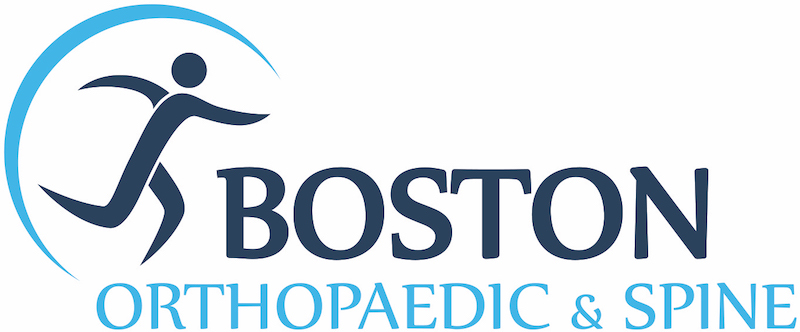The Hip Center
Expertise in Hip Conditions & Procedures
BACKGROUND
The hip is one of the largest weight-bearing joints in the body. Its proper function is critical for sitting, standing, walking, and bending. When you suffer from hip pain, activities such as tying your shoes and climbing stairs may seem impossible.
At Boston Orthopaedic & Spine, our fellowship-trained, board-certified hip specialists are highly skilled at evaluating and diagnosing hip conditions. We see many patients who suffer from hip pain. Let us put an end to yours!
COMMON CAUSES OF HIP PAIN
Hip pain affects patients young and old, regardless of activity level. Common causes of hip pain include:
- Arthritis
- Bursitis
- Tendonitis
- Sciatica
- Hip labral tear
- Femoroacetabular impingement (FAI)
- Fractures
- Complications related to hip replacement
It may be time to seek medical advice if your hip pain has not improved with rest and anti-inflammatory medications. Whether your pain is new, old or the result of a surgery wearing out, we can help.
TREATMENTS
The team of hip experts at Boston Orthopaedic & Spine uses surgical and nonsurgical options to address hip pain and dysfunction. Many patients can recover without surgery and the help of a proper diagnosis, medications, injections, and physical therapy. If nonoperative treatments prove ineffective, surgery may be recommended. Our fellowship-trained surgeons have advanced training in:
Common Hip Conditions
The hip is a large ball-in-socket joint. Unlike the shoulder, which is a similar type of joint, the hip is inherently more stable. It is subject to heavy loads through daily activities such as walking, jumping, running, and squatting. When injured, everyday activities are significantly limited.
With this complex joint, it is best to seek treatment from experts who listen to your concerns and understand your pain. At Boston Orthopaedic & Spine, our board-certified, fellowship-trained specialists have the skill and expertise to treat all of your hip concerns.
HIP ANATOMY
The hip joint is a ball-and-socket joint, formed by the ball (femoral head) at the upper end of the thighbone, and the rounded socket (acetabulum) in the pelvis.
- The bone ends are covered by cartilage, which cushions the bones and provides a near frictionless surface for movement.
- The acetabulum is surrounded by fibrous tissue called the labrum. This tissue deepens the hip socket.
- Multiple muscles and tendons surround the hip joint to provide stability and power motion.
SYMPTOMS OF HIP PAIN
The symptoms associated with hip problems often depend on the history of the problem. In many cases, there is no definite starting point for the pain. The symptoms commonly include pain with walking, pain when using stairs, feelings of instability, stiffness, popping and catching. Classic hip joint pain is usually felt in the groin. Other common locations of hip pain include the buttock, lateral hip, and knee. Additionally, many patients with hip disorders initially complain of pain referred to the knee.
We can generally diagnosis the source of your hip pain with a good history, physical exam, and xrays. In some cases, advanced imaging such as an MRI is useful to confirm our suspicions and identify related issues.
COMMON CAUSES OF KNEE PAIN TREATED AT BOSTON ORTHOPAEDIC & SPINE
Arthritis
Arthritis is painful inflammation and stiffness of the joints, which can be caused by many types of degenerative or inflammatory conditions. There are many types of arthritis, including osteoarthritis, rheumatoid, post-traumatic, septic, and gout. Arthritis symptoms often include swelling, tenderness, sharp pain, stiffness, and sometimes fever and chills.
Bursitis
Bursitis is abnormal inflammation of the bursae, which are normal fluid-filled sacs that reduce friction between bones, tendons, and muscles. This inflammation is caused by an injury, infection or overuse. Pain may be accompanied by swelling, tenderness or loss of movement. Treatment involves stretching, activity modifications, physical therapy, and anti-inflammatory medications. In rare cases, surgery may be considered.Read More…
Femoroacetabular impingement (FAI)
FAI is a condition in which the bones of the hip joint are not shaped properly, causing pain and reduced range of motion. The condition is characterized by the ball and socket shape not matching appropriately and the ball impinging on the socket during movement. Symptoms of FAI depend on the individual, but typically include pain in the groin, lower back or outer hip. Sharp pain may occur when twisting, turning, or squatting.
Fractures
A fracture is a break in a bone. Symptoms of a broken bone include pain (intensified when the area is moved or pressure is applied), swelling, bruising, and loss of function. Fractures may also cause the area around the bone to appear distorted or deformed, especially in open fractures where the bone protrudes from the skin.
A stress fracture is a hairline crack in a bone that can worsen during activity over time. Stress fracture symptoms include pain, which increases with activity and decreases after rest, in addition to swelling and tenderness.
Hip dislocation
Dislocation is an injury to a joint in which the bones are forced out of their natural position by trauma. In a hip dislocation, the head of the thighbone (femur) is forced out of its socket (acetabulum) in the pelvis. Symptoms of a hip dislocation include a visible deformity of the joint and extreme pain. If there is nerve damage from the injury, there may be numbness in the foot and ankle area.
Hip dislocation is relatively rare in a native hip. After joint replacement, there is an increased risk of hip dislocation, with some surgical approaches having a higher risk than others.
Avascular Necrosis (AVN)
Osteonecrosis occurs when the blood supply to a bone is interrupted, causing the bone tissue to die. Most causes are not known, but another very common cause is a history of steroid use Symptoms may include pain in the groin, thigh or buttock, especially when putting weight on the affected leg.
Failed hip replacement
Failure of a hip replacement can be caused by many factors, but the symptoms often include pain, swelling, instability, and stiffness. The hip components are a combination of metal, ceramic, and plastic, and in time, the parts can wear out. If you are concerned that you hip may no longer be working properly, you should see a joint replacement specialist for an evaluation. In some cases, hip revision surgery may be necessary to correct the problem.
Hip labral tear
A hip labral tear is damage to the acetabular labrum, the fibrous cartilage that lines the inner rim of the hip socket. It may be associated with arthritis, or it may occur from trauma or a twisting injury. Symptoms of a labral tear include pain in the groin area, stiffness, and mechanical issues in the hip such as clicking, catching, or locking. Many labral tears can heal with rest, but others may require surgery.
Tendonitis
Tendonitis is inflammation of the tendons, the tissue that connects muscle to bone. Tendonitis is caused by overuse (repetitive motion) or sudden injury. Tendonitis symptoms include pain in the tendon area, swelling, and loss of motion.
Hip Bursitis
A bursa is a fluid-filled space that acts as a cushion between tendons, bone, and skin which helps your joints move with ease. There are over 150 bursae in your body, and several are found around the outer area of the hip, near the portion of your thighbone (the femur) called the greater trochanter. Bursitis occurs when a bursa becomes inflamed, and it is a common cause of pain to your hip.
Inflammation of a bursa is caused by repetitive-use injuries, prolonged pressure, lumbar spine diseases, rheumatoid arthritis, and sometimes infection. It can affect anyone at any age, but is most common in women and the middle-aged. The main symptom is aching pain over the part of the outer hip. The pain worsens with movement or pressure and may travel down the outside of the thigh toward the knee. Pain caused by pressure at night can make sleeping very difficult.
Your doctor will be able to diagnose bursitis when he or she physically examines the specific area causing pain and tenderness. However, an X-ray may be taken to rule out other causes.
Initial treatment of bursitis involves resting, immobilizing the area, and nonsteroidal anti-inflammatory medications (NSAIDs) to reduce inflammation and relieve pain, a regimen that is often effective. Exercise and physical therapy, especially for the hip and lower back, can be helpful to strengthen the surrounding muscles and help prevent further episodes. If these measures don’t relieve your pain, a doctor may recommend an injection of corticosteroids around the bursa, which usually brings rapid pain relief. Surgery to remove the damaged bursa may be an option in severe cases.
To help prevent bursitis, try:
- Stretching your hip muscles before activity
- Practicing good posture
- Avoiding repetitive hip movements that cause the pain
- Cushioning your joints (cushion chairs when sitting, and use extra hip support when sleeping)
If you suspect that you have signs or symptoms of hip bursitis, please see your doctor for evaluation and further discussion of treatment options.
Our Specialist
Daniel C. Mascarenhas, MD
Learn More
Take the First Step
Get an accurate diagnosis and treatment plan from our expert physician team.


